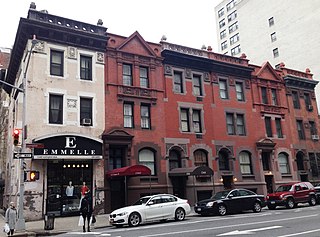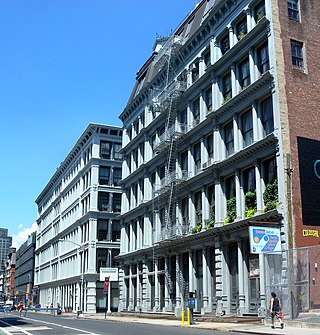
SoHo, sometimes written Soho, is a neighborhood in Lower Manhattan, New York City. Since the 1970s, the neighborhood has been the location of many artists' lofts and art galleries, and has also been known for its variety of shops ranging from trendy upscale boutiques to national and international chain store outlets. The area's history is an archetypal example of inner-city regeneration and gentrification, encompassing socioeconomic, cultural, political, and architectural developments.

The New York City Landmarks Preservation Commission (LPC) is the New York City agency charged with administering the city's Landmarks Preservation Law. The LPC is responsible for protecting New York City's architecturally, historically, and culturally significant buildings and sites by granting them landmark or historic district status, and regulating them after designation. It is the largest municipal preservation agency in the nation. As of July 1, 2020, the LPC has designated more than 37,800 landmark properties in all five boroughs. Most of these are concentrated in historic districts, although there are over a thousand individual landmarks, as well as numerous interior and scenic landmarks.
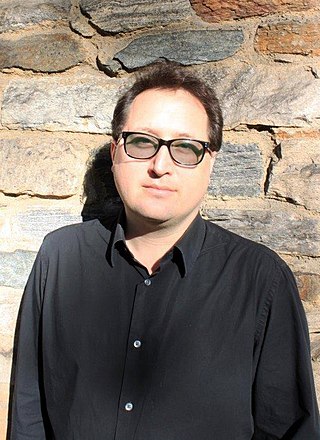
Simeon Bankoff is a New York City preservation activist. He served as executive director of the Historic Districts Council, a New York City, USA, not-for-profit organization, from November 2000 through 2021.
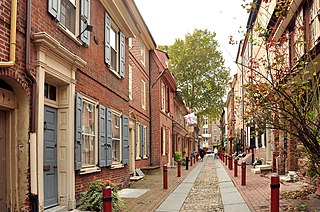
Historic districts in the United States are designated historic districts recognizing a group of buildings, archaeological resources, or other properties as historically or architecturally significant. Buildings, structures, objects, and sites within a historic district are normally divided into two categories, contributing and non-contributing. Districts vary greatly in size and composition: a historic district could comprise an entire neighborhood with hundreds of buildings, or a smaller area with just one or a few resources.

New York City's Theater District, sometimes spelled Theatre District and officially zoned as the "Theater Subdistrict", is an area and neighborhood in Midtown Manhattan where most Broadway theaters are located, in addition to other theaters, movie theaters, restaurants, hotels, and other places of entertainment. It is bounded by West 40th Street on the south, West 54th Street on the north, Sixth Avenue on the east and Eighth Avenue on the west, and includes Times Square. The Great White Way is the name given to the section of Broadway which runs through the Theater District.
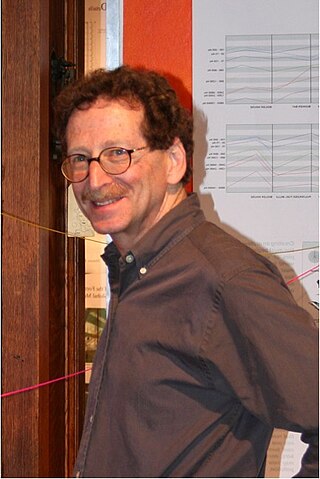
Andrew Scott Dolkart is a professor of Historic Preservation at the Columbia University Graduate School of Architecture, Planning and Preservation (GSAPP) and served as the Director of the school's Historic Preservation Program from 2008 to 2016.
The City of Omaha Landmarks Heritage Preservation Commission, established in 1977, is the Omaha city government's a nine-member board responsible for recommending official Omaha Landmarks to the Omaha City Council. The Landmarks Heritage Preservation Commission is that was established by ordinance in 1977 to review and recommend to the City Council on all matters pertaining to the designation of individual buildings, sites, objects, or entire districts of local historical significance. The commission is staffed by the Landmarks Division of the Omaha Planning Department.

Manhattan Avenue is a street in the Manhattan Valley neighborhood of Manhattan in New York City, extending from 100th Street to 124th Street. Not included in the original Commissioners' Plan of 1811, it is parallel to Columbus Avenue to the west and Central Park West/Frederick Douglass Boulevard to the east.

Village Preservation is a non-profit organization which advocates for the preservation of architecture and culture in several neighborhoods of Lower Manhattan, New York. Since it began in 1980, it has engaged in efforts to attain landmark status for a variety of sites like the Stonewall Inn and Webster Hall. The organization and its Executive Director, Andrew Berman, have been described as influential in New York real estate, while some of its activities to prevent development and to support restrictive zoning have attracted criticism.

The South Village is a largely residential area that is part of the larger Greenwich Village in Lower Manhattan, New York City, directly below Washington Square Park. Known for its immigrant heritage and bohemian history, the architecture of the South Village is primarily tenement-style apartment buildings, indicative of the area's history as an enclave for Italian-American immigrants and working-class residents of New York.

The Church of Our Lady of Esperanza is a Roman Catholic parish church in the Roman Catholic Archdiocese of New York, located at 624 West 156th Street between Broadway and Riverside Drive in the Washington Heights neighborhood of Upper Manhattan in New York City.
Carolyn Wade Cassady Kent was an American historical preservationist and activist who lived most of her life in New York City on Riverside Drive, one block west of her alma mater Columbia University. As founder of Manhattan Community Board 9's Parks and Landmarks Committee and co-founder of the Morningside Heights Historic District Committee she worked to advocate for the architectures and communities of Morningside Heights, Manhattanville and Hamilton Heights in close collaboration with community, city and state organizations and agencies, to effect landmark designations, restorations and interventions that have preserved and protected buildings and entire neighborhoods. In 2007, she was given the first Preservation Angel Award. In addition, Kent served as Secretary of the Renaissance English Text Society.
The Boston Landmarks Commission (BLC) is the historic preservation agency for the City of Boston. The commission was created by state legislation in 1975.

130 West 30th Street, also "The Cass Gilbert", is a luxury condominium on 30th Street between the Avenue of the Americas and Seventh Avenue in Midtown Manhattan in New York City. The 18-story building was designed by architect Cass Gilbert as offices, showrooms and manufacturing space in New York's fur district, just south of the Garment District.











